Nippon India Nivesh Lakshya Fund: A good long term debt fund in the current environment

Retail investors in India have traditionally favoured Bank Fixed Deposits and Government Small Savings Schemes for their fixed income investments. However, fixed deposit interest rates have generally been declining over the last 10 years (see the chart below). Nominal interest rates are directly related to the inflation and GDP growth. As our economy grows in the future, inflation and interest rates will come down even more in the long term, as evidenced in most developed markets.
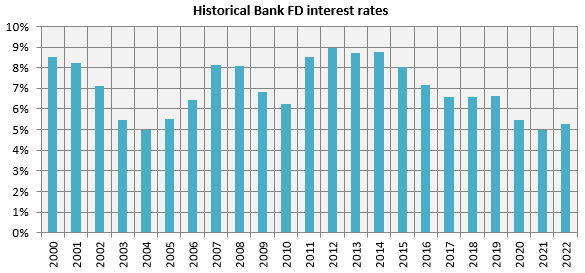
Source: Advisorkhoj Research, SBI 1 year FD Interest Rates. From 1.1.2000 to 31.12.2022
Like Bank FD rates, Government small savings interest rates have also generally been declining (see the chart below for historical Public Provident Fund interest rates). The interest rates of Government small savings schemes are usually linked to G-Sec yields of similar maturities. G-Sec yields in the long term are related to interest rate in the economy. So in the future, we are likely to see further decline in Government Small Savings interest rates as well
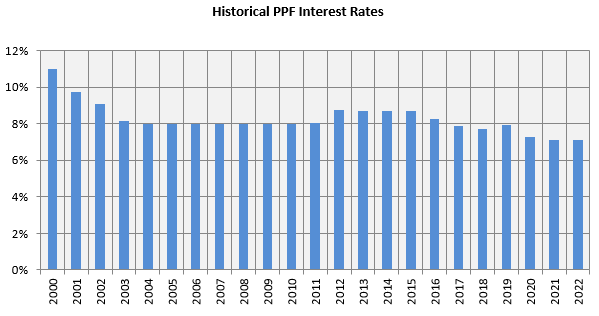
Source: Advisorkhoj.com. From 1.1.2000 to 31.12.2022
Current economic context
Post COVID, world had been grappling with high inflation for a fairly long time. The initial hypothesis of the central banks was that the inflation was transient due to supply chain disruptions caused by lockdowns. However, persistent high inflation even after restrictions were lifted, caused central banks to change tracks. Russia Ukraine war and economic sanctions on Russia further worsened the situation. Central banks have aggressively raised interest rates. The Fed Funds rate in the US is at a 15 year high. High interest rates are now having an impact on the banking system in the US with the collapse of 3 banks and regional banks under considerable stress. Though the RBI has taken a pause in repo rate hikes, the repo rate is at 7 year high. Early sign of liquidity crunch is being seen in our financial system in form of high overnight rates; the banks have already flagged this as a concern to the RBI. The developments over the past 2 – 3 months indicate that we are nearing the possible end of this rising interest rate cycle in light of cooling inflation and declining Index of Industrial Production (IIP) - IIP growth rate slowed to 1.1% in March versus 5.6% in February 2023 (source: National Statistics Office). With telltale signs of global economic slowdown, we expect interest rates to reverse trajectory and start coming down in the future.
What should long term investors do in the current interest rate environment?
Declining interest rates of traditional fixed income investments has long been a concern for many investors, especially investors who depend on the interest income for their regular long term needs e.g. senior citizens. A long term roll down maturity debt mutual fund scheme can be suitable investment options for such investors since it can give higher returns than traditional fixed income investments. The current bond yields can provide attractive investment opportunities for long term debt fund investors (see the Government Bond yield curve below). In this article, we will discuss Nippon India Nivesh Lakshya Fund, a one of its kind scheme in the debt mutual fund space.
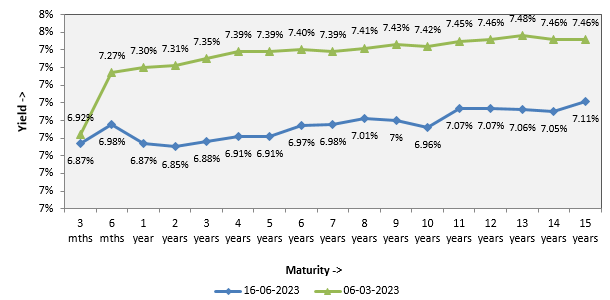
Source: worldgovernmentbonds.com, Advisorkhoj.com. As on 16.06.2023
Who should invest in Nippon India Nivesh Lakshya Fund?
- Investors looking for regular income over long investment tenures
- Investors should have moderate appetite for volatility
- You need to have minimum 3 years investment horizon for this fund
- Over a long investment horizon, you can benefit from higher yields as well potential capital appreciation when interest rates come down in the future.
- You can also invest in this fund for the long term e.g. 7 to 10 years or longer
About Nippon India Nivesh Lakshya Fund
Most long duration funds take duration calls i.e. invest in bonds of different maturities depending on interest rate outlook of the fund manager. Nippon India Nivesh Lakshya Fund is long duration with a difference. The scheme invests predominantly in long duration Government bonds (25-30 year maturities) and intends to hold these securities till maturity to lock-in the current yields for the long term.
The scheme was launched in July 2018 and has around Rs 6,165 crores of assets under management as on 30th April 2023. The expense ratio of the scheme is just 0.53%. Nippon India Nivesh Lakshya Fund has given 9.2% CAGR returns since inception. The chart below shows the growth of Rs 10,000 investment in the scheme from inception. The average maturity of the Nippon India Nivesh Lakshya Fund as on 30th April 2023 is 21.63 years. The portfolio Macaulay Duration is 10.3 years. The portfolio yield to maturity is 7.4%. The chart below shows the growth of Rs 10,000 investment in the scheme since inception. You can see that the scheme has outperformed the Nifty 10 year benchmark G-Sec Index.
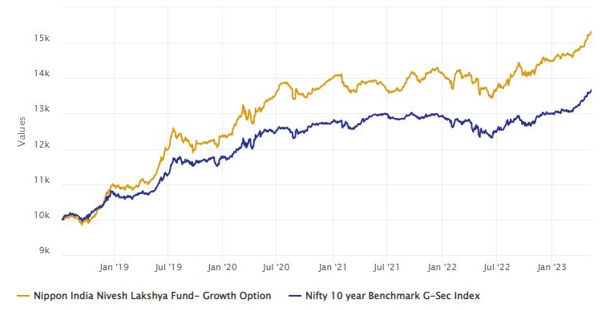
Source: Advisorkhoj Research
SIP is also suitable for Nippon India Nivesh Lakshya Fund
Since Nippon India Nivesh Lakshya Fund is ideally a long term investment, SIP can also be a suitable investment option for this fund. Through SIP, you can invest in this scheme over long investment tenure. You can also benefit from volatility (long duration funds are more volatile than short duration funds) through Rupee Cost Averaging. The chart below shows the growth of Rs 10,000 monthly SIP in Nippon India Nivesh Lakshya Fund since inception. With a cumulative investment of Rs 5.8 lakhs, you could have accumulated a corpus of nearly Rs 7 lakhs in this scheme at an XIRR of 7.2%.
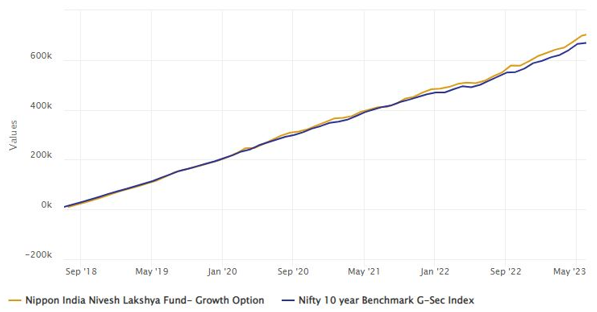
Source: Advisorkhoj Research
Reducing interest rate risk - Roll down maturity
The shape of yield curve is usually upward sloping i.e. bonds of longer maturity give higher yields than a bond of lower maturity. If you buy a long dated bond (long maturity) and hold it, then you lock-in higher yield even as the bond maturity rolls down (reduces). Nippon India Nivesh Lakshya Fund rolls down maturities of the underlying bonds by holding them till maturity. Let us understand this with the help of an example. Let us assume a 10 year bond is available at 6.9% yield while 9 year bond is available at 6.7% yield. You invest in the 10 year bond. So after 1 year, your 10 year bond will effectively be a 9 year bond but with additional 20 bps of yield. Since the duration of the bond reduces over time, the interest rate risk reduces but the yield remains the same.
No credit risk
Credit risk is an important concern for all fixed income investors. While interest rate risk can be obviated if you hold a debt instrument till maturity, credit risk can cause permanent loss. Nippon India Nivesh Lakshya Fund invests only in Government Securities (G-Secs). Government securities have sovereign guarantee and hence there is no credit risk in Nippon India Nivesh Lakshya Fund.
Benefits of Nippon India Nivesh Lakshya Fund
- Visibility of Returns: The current YTM of the scheme portfolio is 7.4%. YTM is the expected return on investment if you hold a fixed income security (bought at current price) till maturity. You can get this yield (adjusted for expense ratio) for the next 20 years or so, if you remain invested in the fund. Unlike funds which take duration calls, Nippon India Nivesh Lakshya Fund will not sell securities to benefit from price movement but continue to accrue the current yields till the maturity of the security.
- Flexibility to withdraw: You can redeem your investments anytime at prevailing market prices. Investors should note that scheme NAV at any point of time will depend on the prevailing market prices of the underlying securities. Prices can go up or down depending on the interest rate situation and other factors – investors should decide accordingly depending on their needs. Nevertheless, the flexibility to withdraw provides an easy liquidity facility for investors not available in several traditional schemes like NSC, PPF, life insurance policies etc
- Can be used to draw out annuities at current (high) yields, using Systematic Withdrawal Plan (SWP). You can get regular fixed cash-flows from your invest in Nippon India Nivesh Lakshya Fund using SWP. The balance units after each SWP instalment will continue to accrue the current (high) yields. You should know that there is no TDS on unrealized gains in debt funds, unlike bank FD where interest income is taxed, whether it is paid out or accrued; you will have to pay tax only on the withdrawal amount. As such, SWP from Nippon India Nivesh Lakshya Fund can be an excellent investment option for senior citizens who are looking for post retirement inflation adjusted returns for long periods of time.
Investors should consult with their mutual fund distributors or financial advisors, if Nippon India Nivesh Lakshya Fund is suitable for their long term fixed income investment needs.
Mutual Fund Investments are subject to market risk, read all scheme related documents carefully.
Queries
-
What is the benefit of mutual fund STP
Aug 29, 2019
-
How much to invest to meet target amount of Rs 2 Crores
Aug 26, 2019
-
Can I achieve my financial goals with my current mutual fund investments
Aug 24, 2019
-
Can you tell me return of various indices
Aug 19, 2019
-
What would be the post tax return on different investments
Aug 18, 2019
-
Which Principal Mutual Fund scheme will be suitable for my retirement corpus
Aug 16, 2019
-
What is the minimum holding period for availing NCD interest
Aug 4, 2019
Top Performing Mutual Funds
Recommended Reading
Fund News
-
Bandhan Mutual Fund launches Bandhan Silver ETF FOF
Jan 12, 2026 by Advisorkhoj Team
-
Bandhan Mutual Fund launches Bandhan Gold ETF FOF
Jan 12, 2026 by Advisorkhoj Team
-
The Wealth Company Mutual Fund launches The Wealth Company Gold ETF FOF
Jan 9, 2026 by Advisorkhoj Team
-
Mahindra Manulife Mutual Fund launches Mahindra Manulife Innovation Opportunities Fund
Jan 9, 2026 by Advisorkhoj Team
-
Jio BlackRock Mutual Fund launches Jio BlackRock Short Duration Fund
Jan 8, 2026 by Advisorkhoj Team














